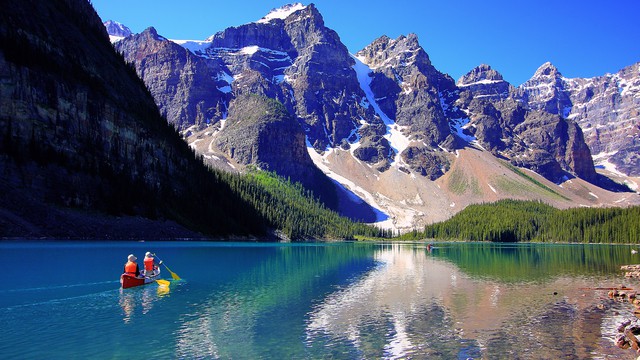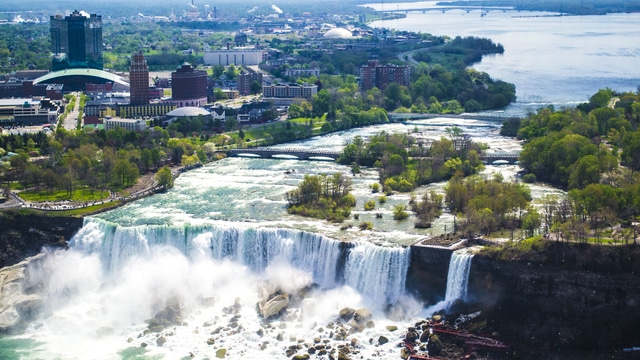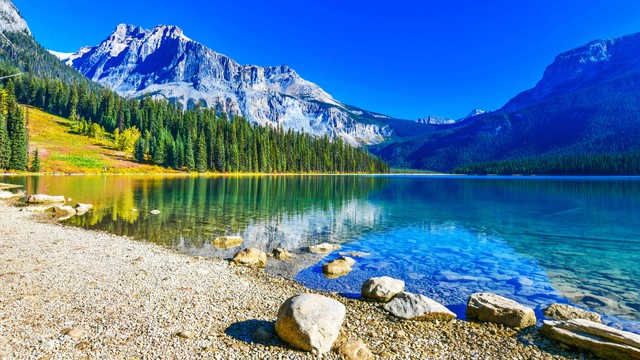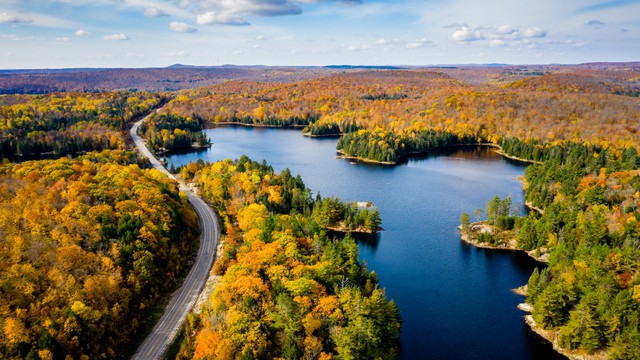What’s the climate like in Rocky Mountains?
The current climate in Rocky Mountains features temperatures ranging from a high of 17°C to a low of -6°C throughout the year. The average yearly temperature is around 5°C. At night, temperatures in the colder months average around -17°C and in the warmer months around 5°C.
The highest temperature recorded in Rocky Mountains in recent years was 35°C in June 2021. The lowest daytime temperature recorded was -36°C in January 2020.
On average, Rocky Mountains gets 1146 mm of precipitation each year. Of this, about 244 cm is snowfall. For comparison, New York gets 1142 mm of precipitation each year.
Curious about the weather in other parts of Canada? Check out the climate and weather for spots like Vancouver, Toronto, Niagara Falls, or explore other destinations in Canada.
Best time to visit Rocky Mountains?
The best time to visit Rocky Mountains for mild to warm weather is June up to August. You might get some rain, but the temperatures are just right to explore Rocky Mountains.
Climate Table of Rocky Mountains
The climate table of Rocky Mountains shows the average temperatures, rainfall, snow, and UV index per month. The table provides an overview of the average day and night temperatures in degrees Celsius, the total amount of rainfall in millimeters, the total snowfall in centimeters, and the UV index for each month. Rainfall is always measured as water, even if it's snow or hail.
| Jan | Feb | Mar | Apr | May | Jun | Jul | Aug | Sep | Oct | Nov | Dec | |
|---|---|---|---|---|---|---|---|---|---|---|---|---|
| Temp. max (°C) | -6 | -6 | -2 | 3 | 10 | 15 | 17 | 17 | 11 | 4 | -3 | -5 |
| Temp. min (°C) | -13 | -17 | -11 | -6 | -1 | 3 | 6 | 6 | 1 | -5 | -11 | -14 |
| Precipitation | ||||||||||||
| Precipitation (mm) | 72 | 66 | 77 | 62 | 75 | 114 | 104 | 106 | 120 | 94 | 154 | 102 |
| Snow (cm) | 22 | 39 | 21 | 15 | 8,1 | 6,8 | 0,8 | 0,2 | 11 | 27 | 62 | 31 |
| UV Index | 2 | 3 | 5 | 7 | 7 | 7 | 7 | 6 | 5 | 4 | 2 | 2 |
Click on the month name to see more weather details, like daily averages, temperatures, and precipitation for the past years in that month.
- Average yearly temperature: 5°C
- Highest temperature: 17°C in July and August
- Lowest temperature: -6°C in January and February
- Precipitation*: 1146 mm per year, averaging 96 mm per month
- Snowfall: 244 cm per year
- Driest months: 62 mm in April, 66 mm in February and 72 mm in January
- Wettest months: 154 mm in November, 120 mm in September and 114 mm in June
*Precipitation is measured as a combination of rain, snow, and hail
Weather experiences in Rocky Mountains
Average Temperature per Month in Rocky Mountains
This graph shows the average maximum temperatures per month in Rocky Mountains, Canada. The temperatures are shown in degrees Celsius and the average is calculated based on the recorded temperatures per month from past years.
Average Precipitation per Month in Rocky Mountains
This graph shows how much rainfall Rocky Mountains, Canada, gets on average per month. Rainfall is always measured as water, even if it's snow or hail. This makes it easy to compare how much has fallen, regardless of the form of precipitation. The amount of rainfall is measured in millimeters, and the average is calculated based on the recorded rainfall per month from past years.
Average Snowfall per Month in Rocky Mountains
This graph shows how much snow Rocky Mountains, Canada, gets on average per month. The amount of snowfall is measured in centimeters and the average is calculated based on the recorded snowfall per month from past years.
Average UV Index per Month in Rocky Mountains
This graph shows the average UV index per month in Rocky Mountains, Canada. The UV index indicates the intensity of ultraviolet radiation and ranges from 0 to a maximum of 11.
Yearly Temperature in Rocky Mountains
This graph shows the average yearly temperature in Rocky Mountains, Canada. The yearly temperature, expressed in degrees Celsius, is the average of all twelve monthly temperatures summed up for that year.
Total Yearly Precipitation in Rocky Mountains
This chart shows the total yearly precipitation in Rocky Mountains, Canada, over the past few years. The total yearly precipitation, measured in millimeters, is the sum of all the rain that fell in the twelve months of that year.
Total Yearly Snowfall in Rocky Mountains
This chart shows the total yearly snowfall in Rocky Mountains, Canada, over the past few years. The total yearly snowfall, measured in centimeters, is the sum of all the snow that fell in the twelve months of that year.
Weather experiences in Rocky Mountains
The weather in Rocky Mountains is rated an average of 4 out of 5 stars by 3 visitors. Have you been to Rocky Mountains? Share your weather experience to help other visitors.
Write your own reviewSeptember in the Rocky Mountains is dynamic! Warm, sunny days alternate with unexpected snowfall. Autumn leaves abound, accompanied by breathtaking snowy landscapes. The weather is changeable. Therefore, prepare with multiple layers of clothing.— This text is automatically translated to English
You have to expect very cold temperatures and lots of snowfall. Ideal for winter sports, but can be problematic for travel and mobility. It is imperative to dress warmly!— This text is automatically translated to English
February in the Rocky Mountains was frigid but incredibly beautiful. Imagine a snowy landscape with bright blue sunny skies. Ideal weather for winter sports enthusiasts, but dress warmly because it can get very cold!— This text is automatically translated to English
Have you been to Rocky Mountains?
Share your weather experiences in Rocky Mountains.
Average weather in Rocky Mountains by month
Click on a month below to see detailed weather info for Rocky Mountains. Based on historical weather data, you can see the average temperature, precipitation, wind, and UV index for each day of the month.
Popular destinations in Canada
Discover the climate of these popular destinations in Canada.












